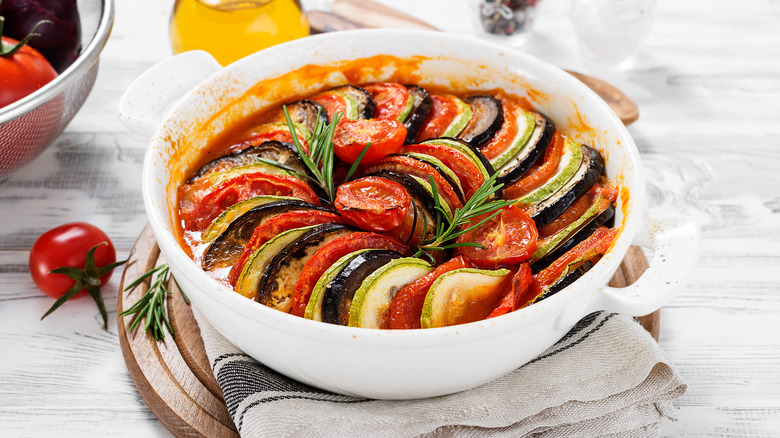Daniel Boulud Has A Unique Take On Ratatouille
Chef Daniel Boulud's love of French food is no secret. But there's a special place in his heart for the country's regional dishes. "In Paris, there is a lot of talent," he tells Departures. "But in Lyon, there is a lot of soul." In the U.S., few regional French dishes boast the same level of notoriety as Lyon's famous ratatouille. And being from that region himself, it's safe to say Bouloud knows a thing or two about the classic dish.
Ratatouille is typically comprised of bell peppers (yellow, red, and green), zucchini, tomatoes, and eggplants. Occasionally there's squash, other times onions, but herbs are always present. When Boulud makes it, he sautés the vegetables separately to give individualized attention to each veggie's ideal cooking time. But that's not what sets his technique apart from other ratatouille recipes. Unlike most recipes for this decadent vegetable dish, he doesn't peel his eggplants, claiming that leaving the skin on retains the flavor. And since all the veggies get slow-cooked in the oven anyway, the skin will soften and won't get in the way of each tender bite.
For a more flavorful ratatouille, don't peel the eggplant
Ratatouille is a Provençal vegetable stew, the signature dish of Nice. Traditionally, ratatouille is a peasant dish commonly prepared by foodies living in the rural countryside and inspired by the vegetables that grow in Mediterranean French household gardens. Even Julia Child raved about the French reverence for local produce in an episode of "The French Chef," sharing, "They have a special way of cooking vegetables, they're not considered just as decorative elements — or worse, as medicine — but as absolutely delicious food that nature has given us and should be cooked with loving care."
It's this kind of thoughtfulness and storytelling that Boulud says makes regional French dishes so special. "I think the food in Lyon keeps evolving and yet it keeps searching back," he tells Departures, "looking back to its history and past and learning from it." The layered complexity somewhat mitigates the reality that ratatouille is, admittedly, pretty time-consuming to make. It takes about two hours in total, but only one hour of active hands-on time, most of which is chopping the star ingredient: the vegetables. Ratatouille can be served warm or cold, but Boulud recommends eating it right away (not that we'd be able to keep our hands off a tureen of ratatouille for very long).

